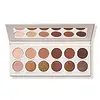What's inside
What's inside
 Key Ingredients
Key Ingredients

 Benefits
Benefits

 Concerns
Concerns

 Ingredients Side-by-side
Ingredients Side-by-side

Mica
Cosmetic ColorantDimethicone
EmollientCaprylic/Capric Triglyceride
MaskingMagnesium Myristate
Polyethylene
AbrasiveTrimethylsiloxysilicate
EmollientSynthetic Fluorphlogopite
Calcium Aluminum Borosilicate
Nylon-12
Methyl Methacrylate Crosspolymer
Silica
AbrasiveBoron Nitride
AbsorbentTriethoxycaprylylsilane
Phenyl Trimethicone
Skin ConditioningEthylhexyl Palmitate
EmollientIsononyl Isononanoate
EmollientTridecyl Trimellitate
EmollientOctyldodecyl Stearoyl Stearate
EmollientIsostearyl Isostearate
EmollientSimmondsia Chinensis Seed Oil
EmollientCocos Nucifera Oil
MaskingButyrospermum Parkii Butter
Skin ConditioningTocopheryl Acetate
AntioxidantCaprylyl Glycol
EmollientEthylhexylglycerin
Skin ConditioningPhenoxyethanol
PreservativeTin Oxide
AbrasiveCI 77891
Cosmetic ColorantIron Oxides
Mica, Dimethicone, Caprylic/Capric Triglyceride, Magnesium Myristate, Polyethylene, Trimethylsiloxysilicate, Synthetic Fluorphlogopite, Calcium Aluminum Borosilicate, Nylon-12, Methyl Methacrylate Crosspolymer, Silica, Boron Nitride, Triethoxycaprylylsilane, Phenyl Trimethicone, Ethylhexyl Palmitate, Isononyl Isononanoate, Tridecyl Trimellitate, Octyldodecyl Stearoyl Stearate, Isostearyl Isostearate, Simmondsia Chinensis Seed Oil, Cocos Nucifera Oil, Butyrospermum Parkii Butter, Tocopheryl Acetate, Caprylyl Glycol, Ethylhexylglycerin, Phenoxyethanol, Tin Oxide, CI 77891, Iron Oxides
Mica
Cosmetic ColorantBoron Nitride
AbsorbentDimethicone
EmollientNylon-12
Zea Mays Starch
AbsorbentZinc Stearate
Cosmetic ColorantPolymethylsilsesquioxane
Glycerin
HumectantSilica
AbrasiveVinyl Dimethicone/Methicone Silsesquioxane Crosspolymer
Zinc Myristate
Caprylyl Glycol
EmollientCyclopentasiloxane
EmollientHydrogenated Lecithin
EmulsifyingIsopentyldiol
HumectantLauroyl Lysine
Skin ConditioningParaffinum Liquidum
EmollientPhenoxyethanol
PreservativePolysilicone-11
Tocopherol
AntioxidantCI 19140
Cosmetic ColorantCI 75470
Cosmetic ColorantCI 77007
Cosmetic ColorantIron Oxides
CI 77891
Cosmetic ColorantMica, Boron Nitride, Dimethicone, Nylon-12, Zea Mays Starch, Zinc Stearate, Polymethylsilsesquioxane, Glycerin, Silica, Vinyl Dimethicone/Methicone Silsesquioxane Crosspolymer, Zinc Myristate, Caprylyl Glycol, Cyclopentasiloxane, Hydrogenated Lecithin, Isopentyldiol, Lauroyl Lysine, Paraffinum Liquidum, Phenoxyethanol, Polysilicone-11, Tocopherol, CI 19140, CI 75470, CI 77007, Iron Oxides, CI 77891
 Reviews
Reviews

Ingredients Explained
These ingredients are found in both products.
Ingredients higher up in an ingredient list are typically present in a larger amount.
Boron Nitride is compound consisting of boron and nitrogen. It is used to absorb oil and modify adherence/ slip in products.
This means it is often used in makeup products to help them last longer.
Caprylyl Glycol is a humectant and emollient, meaning it attracts and preserves moisture.
It is a common ingredient in many products, especially those designed to hydrate skin. The primary benefits are retaining moisture, skin softening, and promoting a healthy skin barrier.
Though Caprylyl Glycol is an alcohol derived from fatty acids, it is not the kind that can dry out skin.
This ingredient is also used as a preservative to extend the life of products. It has slight antimicrobial properties.
Learn more about Caprylyl GlycolCi 77891 is a white pigment from Titanium dioxide. It is naturally found in minerals such as rutile and ilmenite.
It's main function is to add a white color to cosmetics. It can also be mixed with other colors to create different shades.
Ci 77891 is commonly found in sunscreens due to its ability to block UV rays.
Learn more about CI 77891Dimethicone is a type of synthetic silicone created from natural materials such as quartz.
What it does:
Dimethicone comes in different viscosities:
Depending on the viscosity, dimethicone has different properties.
Ingredients lists don't always show which type is used, so we recommend reaching out to the brand if you have questions about the viscosity.
This ingredient is unlikely to cause irritation because it does not get absorbed into skin. However, people with silicone allergies should be careful about using this ingredient.
Note: Dimethicone may contribute to pilling. This is because it is not oil or water soluble, so pilling may occur when layered with products. When mixed with heavy oils in a formula, the outcome is also quite greasy.
Learn more about DimethiconeMica is a naturally occurring mineral used to add shimmer and color in cosmetics. It can also help improve the texture of a product or give it an opaque, white/silver color.
Serecite is the name for very fine but ragged grains of mica.
This ingredient is often coated with metal oxides like titanium dioxide. Trace amounts of heavy metals may be found in mica, but these metals are not harmful in our personal products.
Mica has been used since prehistoric times throughout the world. Ancient Egyptian, Indian, Greek, Roman, Aztec, and Chinese civilizations have used mica.
Learn more about MicaNylon-12 is a polymer. It is derived from 12-aminododecanoic acid, an omega-amino fatty acid
According to a manufacturer, it is a talc substitute. Like talc, nylon-12 gives products a satin feel. The manufacturer also claims this ingredients does not block pores and has moderate oil absorption.
This ingredient may not be reef-safe.
Learn more about Nylon-12Phenoxyethanol is a preservative that has germicide, antimicrobial, and aromatic properties. Studies show that phenoxyethanol can prevent microbial growth. By itself, it has a scent that is similar to that of a rose.
It's often used in formulations along with Caprylyl Glycol to preserve the shelf life of products.
Silica, also known as silicon dioxide, is a naturally occurring mineral. It is used as a fine, spherical, and porous powder in cosmetics.
Though it has exfoliant properties, the function of silica varies depending on the product.
The unique structure of silica enhances the spreadability and adds smoothness, making it a great texture enhancer.
It is also used as an active carrier, emulsifier, and mattifier due to its ability to absorb excess oil.
In some products, tiny microneedles called spicules are made from silica or hydrolyzed sponge. When you rub them in, they lightly polish away dead skin layers and enhance the penetration of active ingredients.
Learn more about SilicaThis ingredient is a combination of red, black, and yellow iron oxide pigments. This combination of colors is usually found in foundation, because it results in a "skin" color.